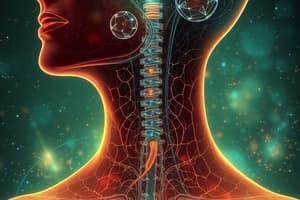Podcast
Questions and Answers
What is the primary role of calcitonin secreted by the C cells of the thyroid gland?
What is the primary role of calcitonin secreted by the C cells of the thyroid gland?
- Stimulate thyroid hormone production
- Lower blood calcium levels (correct)
- Increase blood calcium levels
- Enhance metabolic rate
Which hormone is necessary for the synthesis of T3 and T4 in the thyroid gland?
Which hormone is necessary for the synthesis of T3 and T4 in the thyroid gland?
- Calcitonin
- Thyroid peroxidase (TPO) (correct)
- Thyrotropin-releasing hormone (TRH)
- Thyroid-stimulating hormone (TSH)
Hypothyroidism is primarily characterized by which of the following?
Hypothyroidism is primarily characterized by which of the following?
- Increased metabolism
- Excessive thyroid hormone production
- Deficient thyroid hormone production (correct)
- Enhanced growth development
Which demographic is more commonly affected by hypothyroidism?
Which demographic is more commonly affected by hypothyroidism?
What is the function of the hypothalamic-pituitary-thyroid (H-P-T) axis?
What is the function of the hypothalamic-pituitary-thyroid (H-P-T) axis?
Levothyroxine is commonly prescribed for hypothyroidism. How is its absorption affected?
Levothyroxine is commonly prescribed for hypothyroidism. How is its absorption affected?
Which of these metabolic abnormalities is NOT typically associated with hypothyroidism?
Which of these metabolic abnormalities is NOT typically associated with hypothyroidism?
What is the primary component of colloid in the thyroid gland?
What is the primary component of colloid in the thyroid gland?
Which enzyme plays a crucial role in the production of thyroid hormones by catalyzing the iodination of tyrosine?
Which enzyme plays a crucial role in the production of thyroid hormones by catalyzing the iodination of tyrosine?
What is typically the first-line treatment for primary hypothyroidism?
What is typically the first-line treatment for primary hypothyroidism?
What is a common cause of primary hypothyroidism in the United States?
What is a common cause of primary hypothyroidism in the United States?
Which of the following metabolic abnormalities is commonly associated with primary hypothyroidism?
Which of the following metabolic abnormalities is commonly associated with primary hypothyroidism?
What is the primary goal of treatment for primary hypothyroidism?
What is the primary goal of treatment for primary hypothyroidism?
Which statement about Levothyroxine (T4) is accurate?
Which statement about Levothyroxine (T4) is accurate?
What is the typical absorption percentage of oral T4 (Levothyroxine)?
What is the typical absorption percentage of oral T4 (Levothyroxine)?
What common symptom is often associated with hypothyroidism?
What common symptom is often associated with hypothyroidism?
Which factor can impair the absorption of Levothyroxine?
Which factor can impair the absorption of Levothyroxine?
Which of the following is a physical examination finding in hypothyroidism?
Which of the following is a physical examination finding in hypothyroidism?
What is the usual full replacement dose of Levothyroxine for adults?
What is the usual full replacement dose of Levothyroxine for adults?
Which type of hypothyroidism is indicated by elevated serum TSH and low free T4?
Which type of hypothyroidism is indicated by elevated serum TSH and low free T4?
Which medication is the most commonly used treatment for primary hypothyroidism?
Which medication is the most commonly used treatment for primary hypothyroidism?
What is the primary mechanism of action of thioamides like Methimazole?
What is the primary mechanism of action of thioamides like Methimazole?
Which condition is characterized by elevated levels of T3 and T4 in the blood?
Which condition is characterized by elevated levels of T3 and T4 in the blood?
Which of the following is NOT a common symptom of hyperthyroidism?
Which of the following is NOT a common symptom of hyperthyroidism?
What should be monitored in patients taking thioamides for hyperthyroidism?
What should be monitored in patients taking thioamides for hyperthyroidism?
What is the relationship between T3 and T4 potency?
What is the relationship between T3 and T4 potency?
Increased dosage of Levothyroxine is needed in which of the following scenarios?
Increased dosage of Levothyroxine is needed in which of the following scenarios?
Which of the following conditions typically requires a reduction in Levothyroxine dosage?
Which of the following conditions typically requires a reduction in Levothyroxine dosage?
Which of the following adverse effects is most associated with Methimazole?
Which of the following adverse effects is most associated with Methimazole?
Flashcards are hidden until you start studying
Study Notes
Hypothyroidism
- Definition: Deficient thyroidal production of thyroid hormone.
- Prevalence: More common in women.
- Hypothalamic-Pituitary-Thyroid (HPT) Axis: A crucial feedback loop that regulates metabolism, growth, and development.
- HPT Axis Components:
- Hypothalamus: Produces thyrotropin-releasing hormone (TRH), which signals the pituitary.
- Pituitary gland: Releases thyroid-stimulating hormone (TSH) in response to TRH, which signals the thyroid gland.
- Thyroid gland: Produces T3 (triiodothyronine) and T4 (thyroxine), regulating metabolism.
Causes of Hypothyroidism
- Primary Hypothyroidism:
- Autoimmune disease (Hashimoto thyroiditis): Most common in the US.
- Iodine deficiency: Most common worldwide.
- Surgery/radiation therapy: Can damage the thyroid gland.
- Medications: Lithium, tyrosine kinase inhibitors can interfere with thyroid function.
- Secondary Hypothyroidism:
- Tumors: Pituitary adenoma, craniopharyngioma, meningioma can affect TSH production.
- Trauma: Surgery, irradiation, head injury can damage the pituitary gland.
- Infiltrative diseases: Sarcoidosis, histiocytosis, hemochromatosis can affect the pituitary.
- Chronic lymphocytic hypophysitis: Inflammation of the pituitary gland.
- Drugs: Dopamine and glucocorticoids can suppress TSH production.
Diagnosis of Primary Hypothyroidism
- Thyroid hormone levels:
- Low free T4 (thyroxine) levels.
- High TSH (thyroid-stimulating hormone) levels due to the body attempting to compensate for low thyroid hormone.
- Thyroid peroxidase (TPO) antibodies: Elevated in many cases of chronic autoimmune thyroiditis (Hashimoto's).
- Clinical features:
- Fatigue, cold intolerance, weight gain, constipation, dry skin, myalgia, and menstrual irregularities.
- Physical examination may reveal goiter (thyroid enlargement), bradycardia, diastolic hypertension, and delayed relaxation of deep tendon reflexes.
- Metabolic abnormalities: hypercholesterolemia, macrocytic anemia, elevated creatine kinase, and hyponatremia.
T3/T4 Pharmacology
- Thyroxine (T4)
- Half-life: 7 days.
- Stable and long-acting.
- 80% intestinal absorption of oral T4.
- Triiodothyronine (T3)
- Half-life: 0.75 days.
- Onset of action: 2-4 hours.
- Rapidly absorbed.
- May lead to false TSH suppression if taken close to bloodwork.
- Marked blood level fluctuations.
Treatment of Primary Hypothyroidism
- Goal: Normalize TSH levels.
- Drug of Choice: T4 (levothyroxine, Synthroid)
- Generic vs Brand-name: Bioequivalent but bioavailability may vary slightly.
- Full Replacement Dose: Approximately 1.6 mcg/kg body weight.
- Absorption: More complete and consistent in a fasting state.
- Dosage Timing: Take in the morning or late evening, 30 minutes before breakfast for better absorption.
- Initial Dosage: May start low and titrate up to minimize side effects, especially in patients with cardiovascular disease or the elderly.
- Contraindications:
- Avoid taking with iron, calcium, and other cations as these can impair absorption.
- Dosage Adjustment:
- Increased dose:
- Decreased intestinal absorption due to factors such as dietary fiber supplements, proton-pump inhibitors, malabsorption disorders, bile-acid sequestrants, or medications that bind L-T4.
- Increased need for T4:
- Weight gain, estrogens, pregnancy.
- Increased metabolic clearance of T4:
- Antiepileptic drugs (phenobarbital, phenytoin, carbamazepine), tuberculostatic drugs (rifampicin).
- Decreased dose:
- Decreased need for T4: Weight loss, androgens.
- Decreased metabolic clearance of T4: Old age.
- Increased dose:
Monitoring
- Recheck TSH Levels: 6-8 weeks (1 month) after dose changes and every 6-12 months to ensure optimal thyroid hormone levels.
Hyperthyroidism
- Definition: Elevated levels of T3 and T4 in the blood.
- Causes: - Adenomas/carcinomas: Overactive thyroid due to thyroid cancer. - Thyroiditis: Inflammation of the thyroid, commonly seen in Graves' disease. - Autoimmune response: Causes hyperactivity.
- Note: Hyperthyroidism ≠ Graves' disease.
Graves' Disease
- Most common (60-80%) but not the only cause of hyperthyroidism.
- Autoimmune disorder: Circulating immunoglobulins stimulate TSH receptors, leading to sustained thyroid overactivity.
- Familial component.
- Proptosis: Abnormal protrusion of the eyeball, can be associated with Graves’ disease (thyroid eye disease).
- Symptoms: - Nervousness, irritability. - Tremors. - Palpitations. - Weight loss. - Sweating. - Heat intolerance. - Diarrhea. - Shortness of breath. - Itching. - Exophthalmos. - Thyroid enlargement.
Treatment of Hyperthyroidism
-
Thioamides (methimazole or propylthiouracil (PTU): - Methimazole: - Absorption: Absorbed from the gastrointestinal tract (GIT). - Protein Binding: Most of the drug remains unbound. - Accumulation: Thyroid gland. - Excretion: Slow, 60-70% excreted in urine within 48 hours. - Half-life: 6 hours. - Administration: Single daily dose. - Pregnancy: Not recommended. - Breastfeeding: Not recommended. - Propylthiouracil (PTU): - Absorption: Rapidly absorbed. - Protein Binding: 80-90%. - Accumulation: Accumulates in the thyroid gland. - Excretion: Kidney excretion as inactive metabolites within 24 hours. - Half-life: 1.5 hours. - Administration: Every 6-8 hours. - Pregnancy: Crosses the placenta and fetal thyroid due to high protein binding, but less readily than methimazole, making it the preferred option during pregnancy. - Breastfeeding: Less secreted in breast milk, making it a safer choice than methimazole.
-
Beta-blockers: Help manage symptoms such as palpitations and anxiety.
-
Iodides: Can temporarily suppress thyroid hormone release.
-
Radioactive iodine: Destroys thyroid tissue to reduce hormone production, usually a more permanent treatment option.
-
Surgery: Removal of the thyroid gland, a more invasive treatment option.
Mechanism of Action of Thioamides (Methimazole, PTU)
- Inhibition of thyroid hormone synthesis: - Blocking thyroid peroxidase (TPO), the enzyme that catalyzes the iodination of tyrosine residues in thyroglobulin. - Blocking the conversion of T4 to T3 within the thyroid and in peripheral tissues (PTU).
Adverse Effects of Thioamides
- Monitoring: Need to monitor liver enzymes (CMP) and complete blood count (CBC) to check for granulocytes.
- Common Adverse Effects: Cutaneous reactions (urticaria, maculopapular rash), arthralgia, gastrointestinal upset, hepatotoxicity (mainly with methimazole).
- Most Dangerous Complication: Agranulocytosis, a life-threatening condition involving severely low levels of neutrophils, can occur within 90 days of treatment.
Adrenoreceptor Blocking Agents (Beta Blockers)
- Adjunctive therapy: To relieve the adrenergic symptoms of hyperthyroidism like tremor, palpitations, heat intolerance, and nervousness.
- Example: Propranolol (Inderal).
Anatomy of the Thyroid Gland
- Size: 2 cm (4.4 x 1.5 x 1.3 cm).
- Follicles: The thyroid gland comprises numerous closed follicles filled with colloid.
- Colloid: A secretory substance containing thyroglobulin.
- Follicular Cells: Line the follicles and secrete into the colloid.
- Thyroglobulin: A glycoprotein that is the precursor for the synthesis of thyroid hormones (T4 and T3).
- C Cells (Parafollicular Cells): Secrete calcitonin, a hormone that contributes to the regulation of plasma calcium ion concentration.
Thyroglobulin and Thyroid Peroxidase (TPO)
- Components in Thyroid Hormone Production.
Thyroglobulin
- Function:
- Glycoprotein produced by follicular cells.
- Precursor for thyroid hormone synthesis (T4, T3).
- Stores iodide for later release as thyroid hormones.
Thyroid Peroxidase (TPO)
- Function:
- Crucial enzyme that catalyzes the iodination of tyrosine residues in thyroglobulin.
- Forms precursors of T3 and T4.
- Plays a role in coupling iodinated tyrosine to form T3 and T4.
Studying That Suits You
Use AI to generate personalized quizzes and flashcards to suit your learning preferences.




